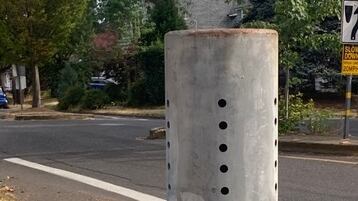What can you tell us about the mysterious cylinders found along Southeast 17th Avenue? They’re about 10 inches in diameter, 36 inches high, and made of what appears to be steel set in a concrete base. Also, they’re hollow—you can tell by the vertical rows of 1-inch holes drilled all around them. Ventilators for an underground squirrel passageway? —Maurice
Don’t be ridiculous, Maurice. There’s no special passageway for underground squirrels; if you have any, just grind them a little longer and put them through the regular squirrel passageway.
Thanks, I’m here all week. Seriously, though, this question did something near-unprecedented: It got my fat ass out of the house for some honest-to-God field reporting. Comparing cues from the reader’s attached photo to Google Street View, I found the exact site pictured. (I’m not giving the address—if you think Jim Morrison’s grave is a mess, you don’t want to see what fans might do to the only known site where Dr. Know ever did any actual work.)
My verdict? Field reporting is overrated. I don’t know if you can see the photo, but I assure you that it’s not hiding any subtle nuances that can only be appreciated in person. I was still stumped. Luckily, sources at the city were able to give me some hints. (They would have given me more than hints if I hadn’t contacted the wrong bureau, but that’s life.)
I’ll end the suspense: What we’re looking at here appears to be a ventilation standpipe for an underground utility vault, also known as a “vault vent.” The words “underground vault” may conjure images of spacious subterranean chambers à la Buffy the Vampire Slayer. Sadly, real-life civil engineers largely ignore the needs of future screenwriters when designing these spaces—they’re no bigger than they absolutely have to be.
Still, over time even small spaces can accumulate hazardous gases (methane, hydrogen sulfide, carbon monoxide, etc.) that can be flammable or toxic or both. Good ventilation keeps the concentration of such gases low. Ventilation also reduces the risk of moisture condensation in the vault, which can result in damage to equipment.
So, there you have it. I couldn’t conclusively establish what this particular vault holds, but the vent’s design is a type sources say is often used in California for electrical wiring and telecom cabling. (There was also a footnote about “mole people,” but it looked boring so I didn’t read it.)
Questions? Send them to dr.know@wweek.com.

